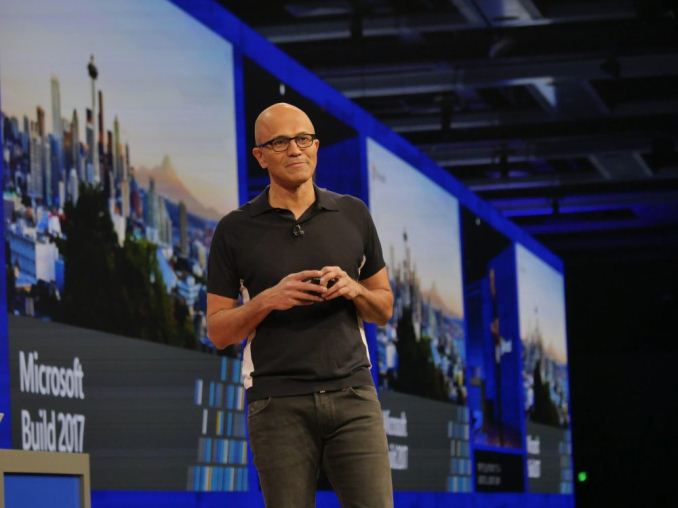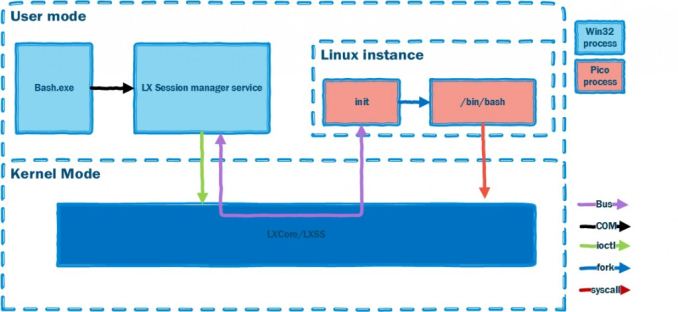The Microsoft Build 2017 Recap: What To Expect When You’re Expecting Windows
by Brett Howse on May 19, 2017 8:00 AM EST
Microsoft’s Build conference is one of their most important shows of the year, with a developer focused discussion that provides some guidance on the direction of Microsoft and its platforms. Over the last couple of years, the platforms have been some of the bigger talking points as well, with Microsoft diversifying across new technologies and markets to try and stay ahead of the curve. Microsoft has predominantly been a platform company over the years, and it’s a rare product they release that doesn’t end up as a platform of some kind. Over the years, the focus on some platforms has had to adjust in order to keep up with the times, and that’s not always an easy goal to accomplish when your original platform, Windows, has been so successful since its inception.
Microsoft had quite a bit of forward leaning news to announce at Build, which we will go over to shed some light on where the company is heading. The company has changed course with their mobile platform never gaining the traction they hoped, and although they have been very successful building out their cloud platforms, for many it’s the consumer facing products that are the most interesting.
Windows 10 Fall Creators Update
Possibly some of the biggest news about Windows actually got announced on April 20, when Microsoft committed to biannual updates for their operating system. This was a welcome announcement, and while some people would argue that it is still too often, when such a large portion of their install base is business, the almost random update interval that came with Windows 10 was unsustainable. IT needs a chance to schedule testing and deployment, and when you have randomly scheduled semi-major updates to the OS, that can be a burden. Having it set in stone for spring and fall should be a much more manageable process, especially since Windows Update for Business will allow them to defer if necessary.
The first big news was a name for the next update to Windows 10, which Microsoft is calling the Fall Creators Update. Perhaps that means the Creators Update should be prefixed with Spring, but the release date and announcement was not unexpected. After the Creators Update arrived with less major changes, and more smaller updates, perhaps there was an expectation that Windows 10 would move to more smaller updates, but the Fall Creators Update looks to be packed with new features.
With the Fall update, Microsoft is looking to refresh the experience again. They are introducing a new experience called Fluent Design, and it appears to be a solid overhaul of the design language for Windows.
Microsoft is also looking to branch out beyond their platform in new ways, with a big push for Cortana and the Microsoft Graph to enable portable experiences across platforms. It’s a smart play when you consider what happened with mobile, and all powered by the cloud.
The Windows Store got a lot of attention, and arguably it’s the part of Windows 10 that needs the most work, especially with the announcement of Windows 10 S where only Store apps will be able to be installed. The Desktop Bridge for Windows has some interesting new customers, and UWP got a lot more API support.
The big surprise at last year’s Build conference was arguable the introduction of the Windows Subsystem for Linux, and that got some more discussion at this conference as well. That, coupled with the new development tools, makes Windows a powerful development platform for much more than just Windows.
As always, it was a busy conference, with plenty of announcements. It’s always exciting to see where the different tech companies try to move the industry, and in what they prioritize in any given year, so let’s dig into the Build conference.













85 Comments
View All Comments
Meteor2 - Saturday, May 20, 2017 - link
One way of thinking about it could be the amount of value created per platform (as GDP type value). While there's probably more mobile client devices around than desktops/laptops, I bet the large majority of value comes from the latter, and always will.mkozakewich - Tuesday, May 23, 2017 - link
While I was impressed by the Stream 7 and other $100 Windows devices, I do wish we had some higher-priced options. I'd love a 7" tablet with OLED, Gorilla Glass, and 4 GB of RAM.BrokenCrayons - Friday, May 19, 2017 - link
I know Linux is still basically a rounding error worth of installed systems, but since Windows 8 was released, the number numbers have show very slow, but steady increases. The fact that it's consistently above 2% now is pretty cool, but for those of us using it, I wouldn't bother celebrating yet. It's got a long way to go before it becomes a significant factor.peevee - Friday, May 19, 2017 - link
"The fact that it's consistently above 2% now is pretty cool"Probably the result of Chinese and Russian governments not wanting to use Windows or MacOS and switching to their domestically cooked distros of Linux.
Meteor2 - Saturday, May 20, 2017 - link
Is that a thing? After all, the Russian government was hit by WannaCry.versesuvius - Saturday, May 20, 2017 - link
People grow up gaming on Windows and along the way pick up some other software which they learn and become dependent on and when they are engineers, doctors, lawyers or housewives or jobless or whatever keep on playing games and software. There is nothing that Linux does not do better than Windows except gaming. That is the whole idea of Windows and as long as Windows is a good platform for gaming the same story repeats itself ad infinitum. Unless of course Linux starts paying more attention to gaming and there is a Linux version of popular games on the market. Another thing that that plays a part in the popularity of Windows albeit not as much as the above is what the late Dennis Ritchie described as its "feeling of Snappiness". The apps do not load any faster on Windows than on Linux and Linux even loads them faster most of the time but the Windows feels snappy, so people feel that are doing something more or their time is not being wasted whereas in reality the time that Windows wastes for its users is almost equal or even more than the time that people spend time actually doing something on Windows.sadsteve - Saturday, May 20, 2017 - link
I now dual boot Windows 10 and Mint Linux. Linux definitely boots up faster for me. It's to the point where the only time I boot Windows is to play a game that's not available on Linux. l could even use Linux for work, if my company would let me, since all the tools I use are available for both OSes.anactoraaron - Friday, May 19, 2017 - link
So with this next major update will they finally stop this insane automatic download and install of garbage apps? Just had to refresh a pc that would no longer join my domain and watched in horror as windows automatically downloaded and installed 10+ apps. Eclipse manager, pandora, adobe express, on and on the apps kept coming. Why oh why do they do this?neogodless - Friday, May 19, 2017 - link
What brand computer? Was this configured by the manufacturer to do this? I've never seen this on a clean install of Windows 10. (Just one... to four... data point(s), though!)Macpoedel - Saturday, May 20, 2017 - link
I have seen this on a clean Windows install, last weekend I installed Windows 10 Pro v1703 (Creator's update) on a NUC, latest iso at that time, and it tried to install all kinds of apps from the Play Store. I don't think Intel could configure this if I brought my own iso, download from Microsoft's website. Maybe hardware manufacturers also have the capability to mark apps as "updates" even when you're using your own install media (kind of like drivers?), but I think this was Microsoft's doing.At first I thought this was some leftover from using the same account on a branded laptop earlier, those apps got tied to my account library and Windows 10 tries to install all of the apps in the library when you set things up. But on the other hand, I haven't setup a branded machine running the factory image since Windows 7... And also, the UWP apps that I actively have installed on other machines, didn't get installed automatically.
So unless my girlfriend is installing those apps behind my back, Microsoft is pushing those apps on us.